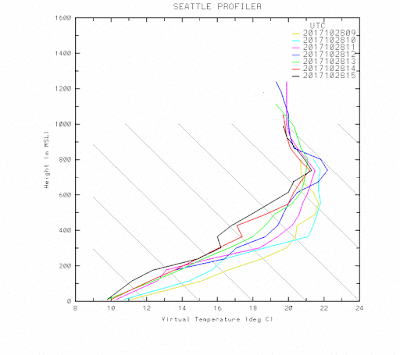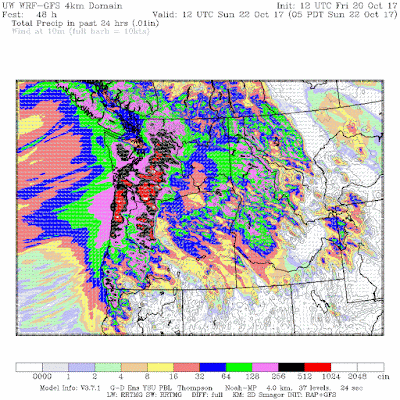______________________________________
Politicians, climate activists, and some media outlets have claimed that there is a strong connection between the recent Wine Country fires north of San Francisco and global warming forced by increasing greenhouse gases. Some samples (could provide dozens more):
 |
| MIT Review |
 |
| Washington Post |
Climate change had little to do with the initiation and severity of the fire.
The truth is that this was a severe weather event, whose terrible impacts (at least 43 dead and tens of billions of dollars of damage) were greatly magnified by poor societal decisions, inadequate planning, poor management of vegetated areas, ineffective use of forecasts, and inappropriate development.
An Extreme Weather Event
The wildfires that hit Santa Rosa and other communities began shortly after a sudden surge of strong winds in the early evening of Sunday, October 8th. At the Santa Rosa RAWS observing location, winds rapidly increased that evening around 9 PM PDT and reached a peak of 68 mph around 5 AM PDT, after which they dropped rapidly (see graphic).
A map of the maximum gusts, mainly from lower-elevation sites based on the NWS MADIS collection, is shown below (the graphic created by UW grad studentConor McNicholas). Note these are in knots (multiple by 1.15 to get mph) Many of lower elevation sites got to 30 knots (35 mph), with higher winds (40 knots plus at sites in or to the lee of terrain). A few sites got into the 60s.
Now it would have been nice to have more observations (especially at altitude), but the observations we do have suggest moderate gusts of 30-40 mph at lower elevations, but MUCH higher winds near the mountain crests and immediately downwind of the crests (60-110 mph). The winds distribution was complex and as shown at Santa Rosa (and elsewhere), the winds came up very quickly around 9 PM, only to subside by daybreak.
As I described in my earlier blog, numerical models provided realistic simulations (and forecasts) of this event. Really quite impressive. As a modeler myself, I have been working with experienced UW WRF modeler Dave Ovens to simulate this event at very high resolution (1.3 km grid spacing). Let me show you a bit of what we found.
The next graphic shows you the forecast winds at about 1000 ft above the surface (which should provide a measure of the max gusts) at 11 PM on Oct 8 (the forecast started at 11 AM that morning). A terrain map is provided for reference.
You notice there is a lot of structure to the wind with highest values over the higher terrain and the upper lee slopes. Winds of 60-65 knots above Santa Rosa. 70-75 knot winds were forecast NE of Geyserville, just where the max winds were observed.


As I noted in my earlier blog, the regional winds from the NE strengthened as cool air and high pressure built to the northeast (eastern Oregon, NE CA). But something special occurred on top of that: huge wind acceleration over and downstream of the local terrain. To show this, let me show you a vertical cross section from the WRF model forecast for 9 PM Sunday, just as things were really revving up. The path of the cross section is shown by the black line below.
Below is the cross section. You can see the terrain, sustained winds by the colors, and the solid lines are something called potential temperature.
Wow. The low-level winds were from the east and greatly accelerated at and west of the crests...in some places to over 70 knots (81 mph)! Keep in mind this was a 10-hr forecast, so strong winds were expected. Other modeling systems did the same thing (e.g., NOAA HRRR, Desert Research Institute/CANSAC WRF).
Why were the winds increased so much by terrain? This is what meteorologists call a downslope wind event with a structure that represents what we call a hydraulic acceleration and jump. This is like water going over a dam and accelerating down the dam's slope.
There was relatively cool, dense air upstream of the terrain and a stable layer/inversion right above. This kind of atmospheric structure really helps produce such acceleration. And small changes in the upstream structure can radically change the winds--you have to get it just right to get the big acceleration.
The conditions that night were ideal to get strong winds over and downwind of the terrain east of Santa Rosa and Geyserville. And it appears highly predictable by state of the art models. We know this was an unusual situation because several of the observing sites mentioned above had record-breaking winds that night (at least as far back as the records went: 1991)
In summary, this was an extreme weather (wind event). There is no denying that.
Why Global Warming Can't be to Blame
Here is why.
(1) Strong downslope winds over northern California are not expected to increase due to global warming
There is no reason to expect that the strong winds had anything to do with global warming. The winds were produced by COLD air moving into the intermountain west, and one would expect that global warming would moderate those temperatures, lessening wind potential. Furthermore, research by my group and others have shown a deamplification of large scale weather disturbances during the warm season, something that is not surprising considering the weakening of horizontal temperature differences by global warming.
(2) Warm temperatures and drought
A number of politicians, media folks, environmental activists, and others have thrown out the argument that droughts and unusually warm temperatures HAD to have contributed to the fires. However, a more careful analysis reveals that this CAN'T be the case in respect to the recent fires.
First, one must ask what was the main vegetation involved in the fires. It was mainly grass, not bushes and trees. Picture after picture demonstrates this, and in many burned locations the trees are still alive and green (see below).
Picture courtesy of Jim Steele
Picture courtesy of CA National Guard
There was more grass than normal going into this summer because of excessive rain, NOT DROUGHT, this last winter. Climate models do not suggest massive increases of rainfall over northern California under global warming. And observed rainfall over the past decades indicate no such trend.
And the dry conditions this summer is absolutely typical for northern California, where rains are generally absent from May to October.
But what about temperatures? Could warm temperatures this summer have contributed to the fires by drying out the vegetation more than normal. The answer is no...and let me tell you why. It is true that this summer was warmer than normal in California, but average summer conditions are plenty warm to do all the drying needed.
The U.S. Forest Service considers grasses 1-h fuels, meaning the dry/warm conditions can sufficient remove the moisture in hours, allowing them to burn. And bushes are generally 10-hr fuels. This was the end of the summer. There was plenty of time to dry out all the vegetation and a few degrees of warming had no impact--the excessive warmth was immaterial. A normal summer would have done the drying job fine.
Take a look at the 10-hr fuel moisture for Santa Rosa for the past five years...no real trend. The moisture goes up in the winter and down in the summer, with no obvious trend on the low side.
Why Blaming Climate Change for the Fires is a Bad Idea
Blaming global warming is a convenient excuse not to deal with the real problems that produced these fires:
- Large number of homes and structures have been built in the Santa Rosa/Napa region over the past 50 years, with population going up by roughly five times. Many were built in bad locations in the forest/urban interface or actually in the forests. Major housing developments were built in regions that had experienced catastrophic wildfires relatively recently.
- Fire has been suppressed in the surrounding vegetated hills, results in the build up of dangerous fuel loads (dry vegetation). A catastrophe ready to happen.
- The electrical system was vulnerable to winds, resulting in the ignition of fires. Furthermore, there have been several suggestions that PG&E has not properly maintained its powerline right of ways.
- Inadequate use of state-of-the-science weather prediction results in a lack of timely warning of a catastrophic situation.
- Lack of robust building codes for a fire-endangered region.
Some politicians are using global warming as a tool for making political points and to avoid the expensive and costly changes required to address this threat.
Global warming due to increasing greenhouse gases will cause many changes, many of them bad, by the end of the century. But blaming unrelated environmental catastrophes on global warming greatly undermines attempts to make the real changes and sacrifices need to prevent such tragedies in the future.
It ain't what you don't know that gets you into trouble. It's what you know for sure that just ain't so. Mark Twain





















































